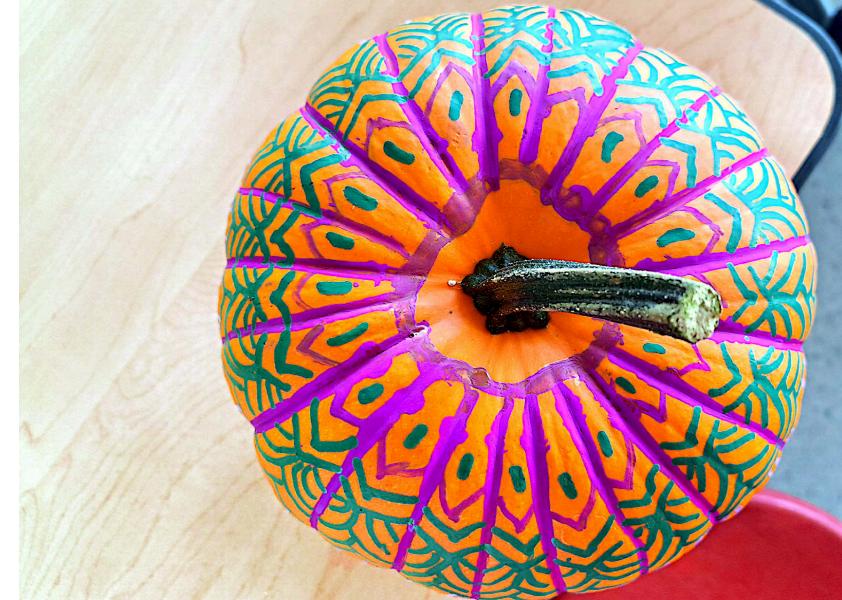

KEYSTONE PENNSYLVANIA
EXPLORING ANCIENT CULTURES AND MODERN CONNECTIONS
EDITOR-IN-CHIEF
EMMANUELLE KRAMER
MANAGING EDITOR
TRACI DOUGHERTY
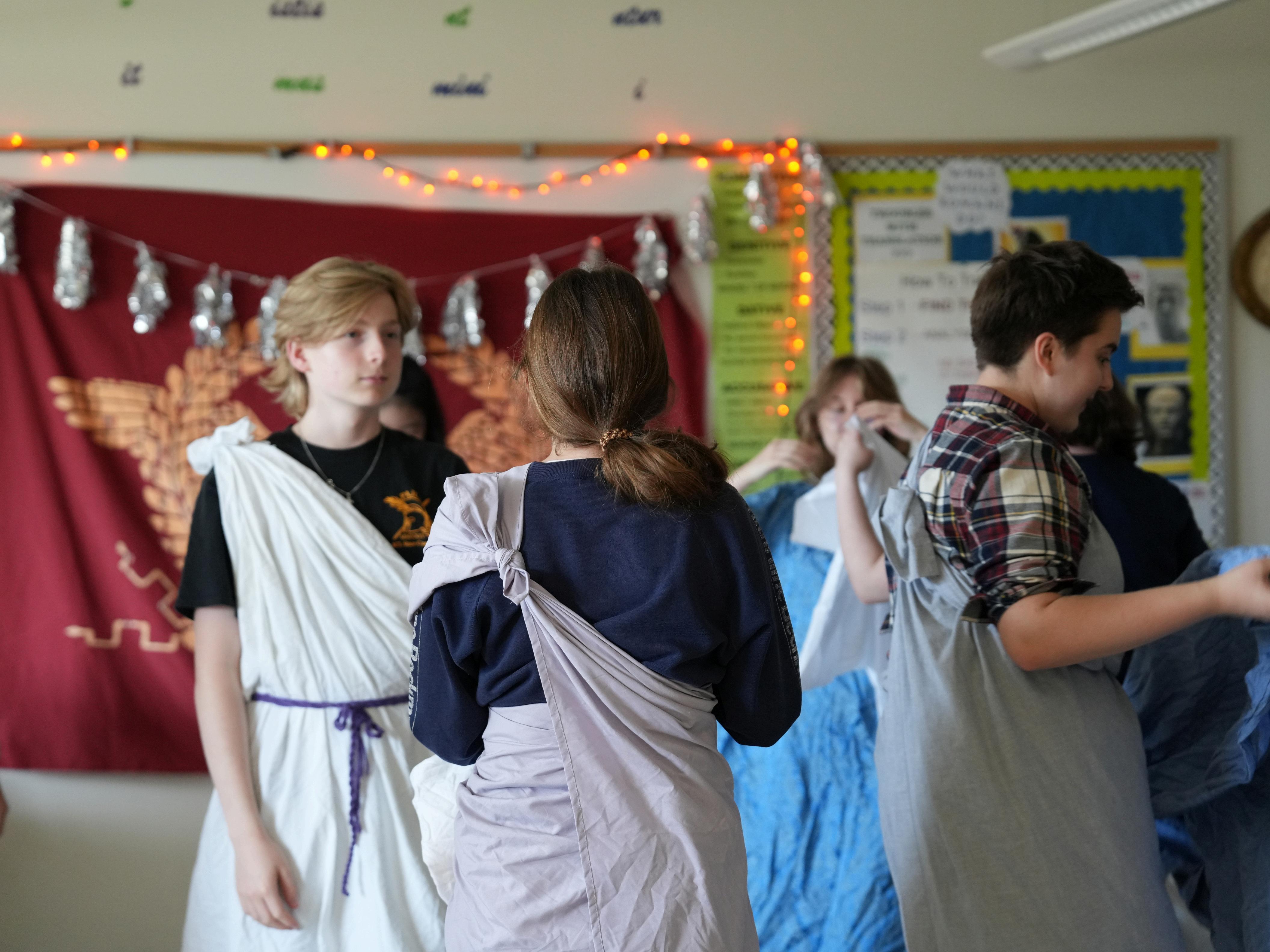
CONTENT DIRECTOR
EMMANUELLE KRAMER
ART DIRECTOR
ARLO DALGARNO PLATT
CONTRIBUTING LEADERSHIP
RYAN ZEITZER
TRACI DOUGHERTY
CONTRIBUTING WRITERS
ARSHIA ZAIDI
CATHERINE FAN
COLE DOOLING
ELIZABETH BOOTH
EMELYN RUDELAVAGE
GABRIEL BASECU
HAZEL CHABALLA
ISABELLA COTTONE
ISABELLA XIE
JULIA XU AND RAE EMMA
KYRAN TALATY
LEXI MILLER
MASON STILES
NADIA YUSKOKO
NOELLA CARLO
RUTHANNE METZGER
SABRINA BAUER



Dive into the world of Roman chariot racing and its surprising parallels with NASCAR
Savor the flavors of ancient Rome with a journey into recipes, dining customs, and their similarities to modern delights.
Learn how the Romans shaped Zodiac traditions that continue to influence our understanding of the stars today
Explore the timeless stories of Jason and Medea through the lenses of two iconic authors
Discover the mystery behind the ancient Sator Square and its meanings across history.
into the approaches the Romans and Greeks took to mark the passage of
FROM THE EDITOR
The role of Latin and Roman culture in schools often takes place in various subjects Some might read Julius Caesar in English, study aspects of the Roman Empire in history, or learn the Latin language But when a multitude of these subjects come together, truly amazing works are completed.
The Keystone is a publication encompassing the beauty of all aspects of classics culture Whether you see yourself identifying with a god/celebrity counterpart, learning about musical instruments in ancient Greece, or admiring modern day chariot racing through NASCAR, there’s something unique for you to take away
Classics is an important part of the world’s historical examination By integrating aspects of Roman culture in interactive formats, readers can find new perspectives in the importance of classical history, language, and culture even in today’s rapidly expanding technological world. Please, enjoy the newly designed KEYSTONE Fall Issue.

EDITOR-IN-CHIEF

08 05 06


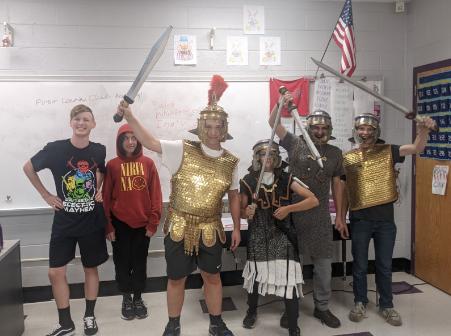
Editor’s Letter
FROM THE CHAIRPERSON
As we approach the 2024-2025 academic year, I’m excited to share some important updates and new opportunities for all Pennsylvania Junior Classical League members.
New Leadership
We’re thrilled to welcome our new student and adult leaders for the year: Sabrina Bauer of Upper Dublin High School (Vice President), Chris Chang of Harriton High School (Secretary), Sohum Bandyopadhyay of Owen J Roberts (Parliamentarian), Emmanuelle Kramer of Upper Dublin High School (Editor), and Magistra Sara Flounders of Bala Cynwyd Middle School (Certamen Chair)
Latin League: A New Year-Long Challenge
We promoted Latin League, a virtual year-long competition that fosters teamwork while challenging students' Latin skills Middle and High School Teams have been competing regionally since October with a national final upcoming
NEW Keystone Magazine
Our Keystone magazine has been upgraded Check out the new look and contribute your articles to earn valuable points for your school! The remaining deadlines for the year: Winter: February 7th, Spring: March 28th and Convention Edition: May 30th.
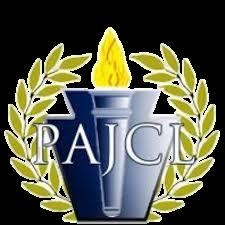
Senior Classical League (SCL) Refresh
We are actively recruiting new members and leaders for the Senior Classical League (SCL), our college-level organization This year, we will need a strong presence of delegates to approve an updated constitution If you're interested in shaping the future of the SCL, now is the time to get involved!
PAJCL Convention 2025
The PAJCL Latin State Convention will be held on May 24th-25th at Penn State University
The cost is $200 per participant. Nota Bene: Ensure your chapter is in good standing with PAJCL and NJCL by January 31st, and submit delegate packets by February 14th
Look out for more details about event sign-ups, dorming, convention schedules coming in January and February Also, be sure to review updated PAJCL guidelines and forms as they’re released
This year promises to be an exciting one for the PAJCL community I look forward to seeing you at the convention and hearing all the great contributions from students across the state!

PAJCL STATE CHAIRPERSON
CONTEST UPDATES
PENNSYLVANIA SHINES AT THE NJCL NATIONAL CONVENTION
By Traci Dougherty, PAJCL Academics Chair
This summer, we are thrilled to celebrate the outstanding achievements of Pennsylvania’s Latin scholars at the National Junior Classical League (NJCL) Convention held at the University of Tennessee in Knoxville! Competing against top students from across the country, our delegation demonstrated remarkable skill, dedication, and school spirit
Our talented students excelled across a variety of categories, including creative arts, athletics, and academics, showcasing their passion for the Classics on the national stage. Building on their success in state and regional competitions, Pennsylvania earned impressive awards, highlighting their unity and enthusiasm
The collective efforts of our Pennsylvania delegation were truly extraordinary, and their achievements reflect countless hours of preparation, the guidance of dedicated teachers, and their own enthusiasm for Latin and the ancient world.
Congratulations to our incredible scholars for representing Pennsylvania with pride and distinction at the National Convention! You have brought great honor to our state and the entire PAJCL community
We can’t wait to see what you accomplish next!
Sports and Ludi
Ludi Kickball: 2nd Place: Virginsylvania (VA/PA)
Relays Co-Ed: 3rd Place: Messifamia (MA, FL, AL, PA)
Membership State Chapter Net Growth: (PA)
Competitive Certamen:
Advanced: 1st Place: Harry Lau, Justin Glozman, Noah Tomforde Toates and Lev Weitzman

Academics:
Academic Heptathlon: 4th Place: Harry Lau
Ancient Geography 4: 2nd Place: Lev Weitzman
Reading Comp Prose 5: 4th Place: Noah
Thomforde Toates
Reading Comp Poetry 5: 2nd Place: Noah
Thomforde Toates
Roman History 4: 2nd Place: Lev Weitzman
Roman History 5: 4th Place: Justin Glozman
Mythology 5:
3rd Place: Harry Lau
Latin Literature 5: 3rd Place: Harry Lau
Latin Grammar 5: 5th Place: Noah
Thomforde Toates
Classical Greek: 3rd Place: Reesey Lai
Creative Arts:
Traditional Photo 11-12
3rd Place: Dariya
Cambria (PA)
Mixed Media 11-12
5th Place: Dariya
Cambria (PA)
Small Models 11-12
1st Place: Dariya
Cambria (PA)
CHAPTER EVENTS
UPPER DUBLIN HOSTS FALL FEST
Date: October 15, 2024
Location: Sandy Run Middle School
Latin enthusiasts from ten schools across Pennsylvania gathered for the annual Fall Fest, hosted by Sandy Run Middle School. The event was packed with activities that celebrated classical culture, learning, and camaraderie
Participants engaged in exciting Certamen matches, tested their creativity in the Cupcake Wars competition (with over 150 entries!), and enjoyed an Oculus VR experience that brought the arenas of ancient Rome to life. Upper Dublin students shined throughout the day, taking top honors in the Certamen finals and earning the People’s Choice Award for Cupcake Wars.
The marketplace, featuring student-crafted items like themed T-shirts and artwork, was another standout feature, fostering connections between students from across the state Athletic events like the chariot races and ultimate frisbee kept the energy high, with spirited competition and plenty of laughs.
Key Highlights:
Certamen Victories: Upper Dublin secured 1st place in the advanced category
Cupcake Wars: Upper Dublin swept both the Popular Vote and Judges' Choice categories
Chariot Races: Team Red Lightning won by a narrow margin, drawing cheers from the crowd.
We look forward to welcoming everyone back next year for another unforgettable Fall Fest
Sabrina Bauer, a senior at UDHS, is a dedicated student leader and active member of her community She serves as co-president of the Latin Club, vice president of the PAJCL board, treasurer of the Library and Media Club, and secretary of the Archery Club Additionally, she is a Thespian in Drama Club, a member of the Choir Executive Board, and participates in MiniThon, LifeSmarts, National Honor Society, and Chorale Outside of school, Sabrina is a Girl Scout, captain of her club volleyball team, and enjoys reading and crocheting in her free time


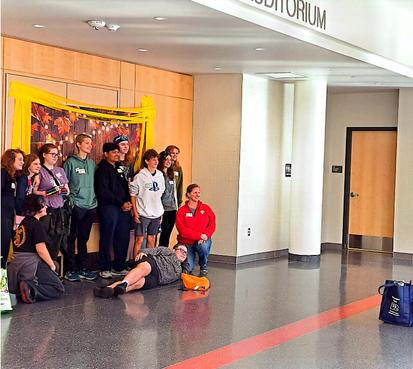
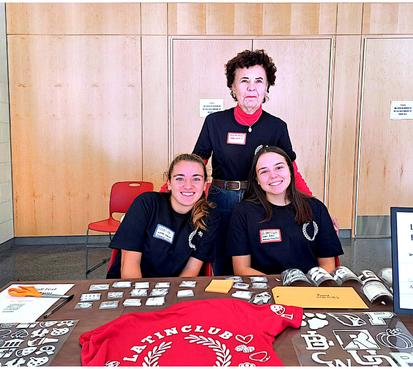

HUMOR & LIFESTYLE
DIGITAL ART: PAVO PILEUS
To anyone seeking a delightful blend of ancient Roman tradition and vibrant creativity, this whimsical image of a peacock donning a pileus to celebrate Saturnalia is sure to captivate
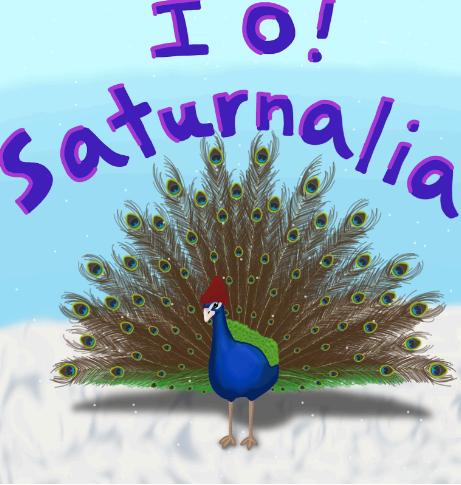
Isabella Cottone is a senior in AP Latin at Owen J Roberts HS, and is the 2024-2025 Treasurer for her school’s Latin Club She loves going to Latin related events, tests, and competitions like the State Convention Her hobbies and interests include baking, gaming, petting cats, DND club, and skiing club
Gabriel Claus Basescu is a freshman at Harriton High School and a proud member of the Latin Club, where he has earned both gold and silver medals on the National Latin Exam Passionate about language learning, film making, and social activism, Gabriel also enjoys sharing his love for Latin with friends and exploring creative and academic pursuits
TAKE THE POLL: AENEID
What sounds more appealing: being a powerful goddess, a fearless warrior, or the ruler of a thriving city? This poll invites Latin students to reflect on which character from the Aeneid they connect with most—and why they see themselves in that role.
POEM: MEDUSA
You kill me. You love me.
You strike me
You indulge me
You torment me. You pleasure me
You insult me
You flatter me. You kill me
And once over for good measure
For my beauty I was tortured, For my disfigure I was executed
My monster is your desire,
Though you treat me as my own
No place is safe for me
No hearth, no home
I am to embrace my predator
For he could never want of heroism
No matter that he swings a blade
No matter that he directs to me
Any act of self defense Will always twist to villainy
And through the depths of my agony
A small light to shine
But you steal that away too
My choice is no longer mine
My sisters are spared neither For though they are not slain as me
They are now forced to grieve You kill me
And you kill me again
It will never be enough
Begrudgingly, I end
HUMOR & LIFESTYLE
GAME: CONNECTIONS
Test your knowledge of Roman culture with this exciting Connections Game! Explore the fascinating world of Roman life, including their food, clothing, housing, and family traditions Do you have what it takes to master the challenge?

Hazel Chaballa is a freshman at Upper Dublin High School She is an active member of Mini-THON and serves on the SGA General Assembly Hazel is also a dedicated athlete on the UDHS water polo team and enjoys playing basketball for fun Outside of school, she loves spending time with her friends and family
COMIC: SACRIFICE SEASON
Roman festival of Fordicidia, celebrated annually on April 15th in honor of the earth goddess Tellus. As the deity associated with the fertility of the land, Tellus was central to this agricultural holiday. The ritual involved the sacrifice of a pregnant cow, symbolizing the renewal of life and ensuring the fertility of both the soil and livestock for the coming season
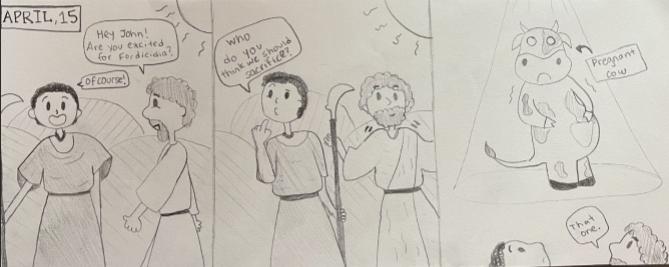
Isabella Xie is a senior at Upper Dublin High School with plans to pursue a career in nursing In her free time, she enjoys listening to music and spending quality time with her beloved cat
CLUB UPDATES
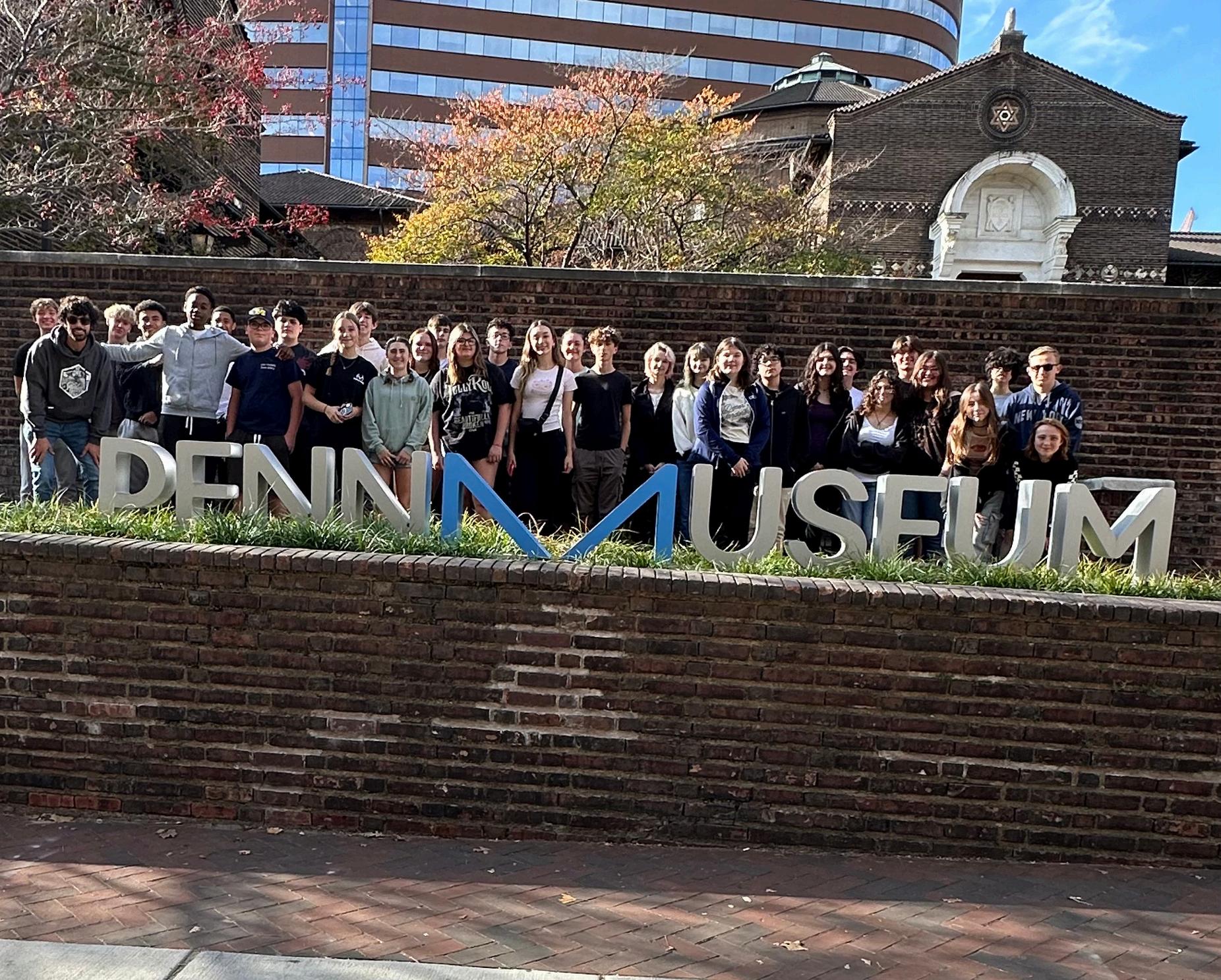
ACROSS THE STATE
As the fall semester unfolds, PAJCL chapters across the state have been bustling with activity, creativity, and community engagement From spirited competitions to meaningful service projects, these chapters are showcasing the enduring relevance of classical studies in modern student life.

CLUB UPDATES


The Upper Dublin Latin Club kicked off the fall semester with excitement and community spirit. In September, the Club Fair and Ice Cream Social brought students together, fostering connections and planning for the year. October featured a creative Pumpkin Painting Party and the lively Fall Fest, where students enjoyed Certamen matches, T-shirt swaps, and pizza alongside neighboring PAJCL chapters. In November, the club hosted Cerealia, celebrating with a cereal bar, and organized a Food Drive to support local families. UDJCL looks forward to December’s Saturnalia Celebration, continuing its mission to celebrate the classics while building a strong community
The North Allegheny Junior Classical League chapter has been busy with fun events so far this year! In October, NAJCL hosted an introductory meeting to allow new members to experience the excitement of JCL and bond with other club members, complete with a pumpkin decorating contest, a virtual escape room, and snacks In December, the highly anticipated Saturnalia celebration came around, where members enjoyed entertainment, a photo booth, and an elaborate feast along with desserts During the Saturnalia celebration, NAJCL members also had the opportunity to participate in a fun gift exchange to build connections with fellow members, and, perhaps most excitingly, an official induction ceremony was held for new members Students new to JCL received bullae with special treats inside, a playful way to welcome them to the flourishing and closeknit community that is NAJCL NAJCL has much in store for next year, and is excited for our community to continue to grow!



NASCAR VS. CHARIOT RACING
“You
feel your heart begin to pound out of your chest and the crowd begins to blur. You're going faster than ever before.”
NASCAR is now more popular than ever; even racing around the Las Vegas Strip. It is easy to see racing technology evolving.
Still, it’s important to remember what came before NASCAR -Chariot Racing.

A single horse pulling a cart around a track seems prehistoric compared to today’s 750horsepower cars However, there are still many similarities between the two. The greatest similarity between NASCAR and chariot racing is the world of betting, especially in Rome The Greeks ran 12-lap races; the Romans, on the other hand, ran 7lap races to create more betting opportunities
This year during the Las Vegas races there were many betting opportunities including inperson betting, the race did happen in Las Vegas after all, and a plethora of online opportunities. Another minor difference is during chariot racing the fastest horses and carts would race in the outside of the track making it easier to pass slower vehicles. In modern-day NASCAR it is the exact opposite The faster cars stay in the center lanes making them even faster since they are able to cut out additional distance Cars still pass each other but require more effort to move into an outside lane to overtake.
Besides minor differences, the basis of the sport has mostly remained the same There are participants in their vehicle and they compete to be the fastest. Yes, NASCAR participates in longer-distance races and the technology has improved but what hasn’t?
Chariot racing set the blueprint for what NASCAR has become Whether you are Richard Petty, commonly referred to as the “King of NASCAR,” or a Roman charioteer from almost 2,756 years ago, your heart will begin to pound as you approach the starting line.
As the race begins the crowd will begin to blur and everyone will have their eye on one thing the prize. When you're watching the cars zoom around the track, going so fast you can barely see them, remember what came before NASCAR and what came before 750 horse powered cars
A single horse pulling a cart. The Roman chariot races.
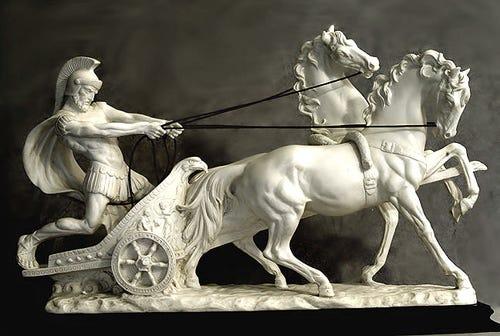
COLLECTING ROMAN COINS: THE CHALLENGES AND DISCOVERIES

Later, the as was replaced by the sestertius, which translates to "two and a half" because it was worth two and a half asses
Intricate details on Roman coins reveal the stories of emperors and the economy of ancient Rome

Here are some quick tips to help you identify and date your coins:
Look for the Emperor's Portrait 1
Check the obverse (front) of the coin for the emperor’s image
Pay attention to hairstyles, facial features, and any unique attributes (e g , crowns or laurel wreaths)
2. Read the Inscription
Roman coins often include the emperor’s name and title in Latin Common abbreviations:
IMP = Imperator (Emperor)
AVG = Augustus
COS = Consul
3. Examine Design Elements
Clothing or accessories can signify specific achievements (e g , military victories or religious roles)
Symbols like animals, temples, or gods may provide historical context
4 Check the Reverse (Back)
The reverse often features imagery or inscriptions commemorating events, deities, or important Roman values like peace (PAX) or victory (VICTORIA).
5. Material and Size
Gold coins (aurei), silver coins (denarii), and brass or bronze coins (asses or sestertii) can often be identified by their material and weight
6. Look for Edge Modifications
Notches or cuttings on the edges might indicate ancient tampering
7. Use Reference Guides
Books and online databases can help you match your coin to known examples Popular resources include: Roman Coins and Their Values by David R Sear or online databases like Wildwinds or the British Museum’s coin collection
The composition of my coins made it easy to identify them as asses, sparing me the difficulty of distinguishing between silver denarii and sestertii
Coin Cutting and Counterfeiting
An intriguing feature of my coins is the deliberate notches on their edges. These notches weren’t just wear-and-tear they were deliberate cuttings made by ancient Romans attempting to profit from their currency By shaving off small amounts of metal from the edges of coins, they could melt the shavings down and mold them into new coins, essentially creating counterfeit money
To combat this practice, Roman financial authorities implemented various measures, though with limited success. Interestingly, the most effective method to prevent coin cutting wouldn’t come until centuries later. The ridges on the edges of modern US coins commonly seen on quarters and dimes serve as a safeguard against similar practices These ridges act as markers to assure sellers and banks that the coins haven’t been tampered with. While this is less relevant today, as coins hold less value compared to paper bills, the innovation had a significant impact on curbing counterfeiting in its time
Reflections on Collecting
Collecting Roman coins has been a fascinating journey of historical discovery and detective work Each coin tells its own story, not only through its designs and inscriptions but also through the marks left by its use and misuse The practice of dating and identifying these coins has deepened my appreciation for the complexity of ancient economies and the ingenuity of the people who participated in them. Through my collection, I’ve learned that even small objects can open doors to a vast history and that sometimes, the details that seem insignificant at first can reveal the most compelling stories
THE SHAPING OF ASTROLOGY
“The Roman tradition of astrology is deeply intertwined in today's popular culture.”
Astrology in Ancient Rome was an important piece of their political and cultural world. Although astrology can be traced back to earlier civilizations such as the Babylonians and Egyptians, the Romans transformed it into something even greater.


ucture of the Babylonian zodiac and eir own mythology and culture Roman ned to each of the twelve zodiac signs. diac relatable to Roman citizens as well as c meaning that reflected Roman values developed horoscopic astrology, drawing d on the position of celestial bodies at a
onsulted astrologers to seek guidance tical or personal decisions Emperor s sign, Capricorn, to prove his right as a me As the zodiac grew in importance, it nd literature throughout Ancient Rome. It those in all social classes, creating between the people of Rome
on of astrology is deeply intertwined in ulture. Astrology continues to gain any people refer to their sun signs, read n or guidance, and incorporate zodiac on and art Similarly, this modern strology reflects the Roman use of ans of guidance and source of inspiration.
a vital role in molding the zodiac system astrological practices that have carried well ra By blending astrology into their day life, and political systems, they ation upon which we base our d relation to the zodiac today. The Romans' rology has made a lasting impact on nding of the connection between human
os a senior at Upper Dublin High School and serves as Vice ub She is also the President and an attorney for her m Outside of academics, Emelyn enjoys hiking, painting, her beloved rabbit, Rosie
ART & ARCHAEOLOGY
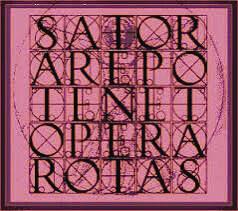
The enigmatic Sator Square, a palindrome-rich word puzzle with centuries of interpretations
SATOR SQUARE
The sator square is a mysterious archaeological find and there are many theories on its use and existence. It is composed of twenty five letters that fill a five by five letter grid The letters read “SATOR AREPO TENET OPERA ROTAS” this is thought to mean “The sower, Arepo, works the wheels with care.” The word Arepo is found nowhere else so experts assume that it must be a name
One of the most interesting observations of the square is that there is a pattern. The square is an acrostic palindrome, meaning it reads the same forwards, backwards, up, and down
The oldest Sator Square was found in Pompeii, but there have been many others found elsewhere in the ancient Roman world The square has been seen differently by many different cultures and religions Some words included such as sator and tenet made Christians believe that it has a religious meaning
While in 12th century Europe, the square was mostly seen to have healing properties. Medical textbooks said that if you carve the square into bread and then eat the bread, it could treat fevers and rabies In the medieval age, it was believed to have magical properties and this belief continued in some way because German settlers believed this into the 20th century
There are many conflicting theories about the history and uses of the square. Some experts believe that it was just a word puzzle. Some evidence that supports that theory is that there was another square found in Pompeii with similar properties except that it does not form a sentence
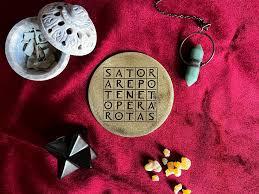
What I find most interesting about the Sator Square is how many theories have been developed around what was likely just a word puzzle It makes me wonder what people in the future would think about our current word games such as a crossword puzzle or even Wordle.

ROMAN RING FOUND IN ISRAEL: EMPIRE’S REACH

“To understand your present world, you have to understand the past.”
A Roman ring has been discovered in Israel But what does this mean? And why should we care? Well, the city of Rome is about 2,520 miles from the city of Jerusalem. That's a long distance. So long you might not be able to comprehend it So long it might make you wonder: how did that ring go all that way?
Flashback To The Roman Empire
The Roman Empire, at its height, was massive It covered much of Asia, Europe, and Africa. It stretched from Britain in the north to Egypt in the south, and from Spain in the west to Iraq in the east, covering about 3 million square miles. That’s a lot. Almost 20% of the world’s population lived under Roman rule That’s also a lot Roman culture, architecture, and language shaped the world, and eventually, the empire became the center of Christianity.
A Journey Across 2,500 Miles
Speaking of Christianity, this guy showed up in Jerusalem, named Jesus Maybe you've heard of him. During that guy's time, the Romans had conquered so much territory that they spanned that aforementioned 2,520 miles For context, that’s about 44,000 football fields. Yeesh! Try playing on that, Tom Brady
Why Artifacts Like These Matter
To understand your present world, you have to understand the past. The discovery of a Roman ring in Italy is more than just a cool archaeological find It’s a reminder of how connected the ancient world was. The Roman Empire wasn’t just massive It was a network of people, goods, and ideas that traveled thousands of miles. Its impacts are still felt today. Ever taken a bath? So, the next time you hear about ancient artifacts, think about how even tiny things like a ring can shine light on our world

LIFESTYLE & CULTURE
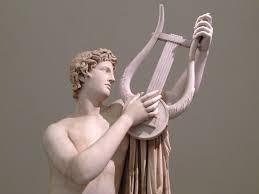
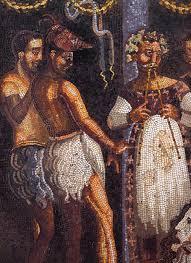
MUSIC IN GREECE
Among the mythology, philosophy, medicine, government, math, and other contributions of Ancient Greece, music is often overshadowed, despite it being deeply ingrained in the culture. Greeks included music in every aspect of life such as festivals, marriages, funerals, banquets, theatres, worship, and in the home

A wide variety of instruments were used in Greece, but the lyra, kithara, and aulos are a few that are considered to be the most popular or prominent
The lyre was similar to a modern harp or guitar It was vaguely u-shaped by two arms and a crossbar, and strings ran vertically along it (the number of strings varied). The lyre was used for instrumental music or to go along with singing or poetry
The kithara was similar to a lyre, but it was larger and had seven strings It was mainly used by professionals, as its larger soundbox allowed for greater projection, making it suitable for concerts
The aulos was a wind instrument. It was a pipe played with a reed and seven holes down the length of the pipe (think of a flute or a recorder). Some had double reeds and pipes; the player would hold one pipe in each hand and play them at the same time The aulos was a very common instrument, but a few of its uses were in ceremonies, athletic events, and plays
The Greeks viewed music as a gift from the gods, and some gods were known for creating a certain instrument For example, Hermes created the lyre, Athena the aulos, and Pan the syrinx (another wind instrument, also known as the panpipe) Music was strongly associated with singing and dancing, and it was usually monophonic, meaning only one melody existed without other harmonies or chords Despite this contrasting to most modern music, the Greeks did have an impact on it. We get many of our musical terms from them such as symphony, chord, chorus, melody, harmony, rhythm, and ode. Additionally, many modern instruments have similarities to older Greek ones, such as the kithara and lyre resembling guitars or the aulos resembling modern woodwind instruments So, music is yet another item to add to the extensive list of Greek contributions.
“Music was strongly associated with singing and dancing, and it was usually monophonic, meaning only one melody existed without other harmonies or chords.”

ROMAN COOKING
As Thanksgiving rolled around and we were all spending a little more time in the kitchen and at the table, I began thinking about how the Roman customs of cooking and eating
Food in Ancient Rome was mostly eaten raw among common people because using fire inside homes posed significant dangers However, when foods were cooked among the wealthy, it sometimes happened at the focus, a hearth that was placed in front of the lararium. After the development of the culina, however, the focus began to be used for religious offerings instead The culinae walls and floors were made of stone, tiles, or bricks. They were usually placed on the corner of each house in order to minimize smells and smoke, prevent fire, and because it was operated by enslaved people In the culina, there were portable stoves and ovens (furnus) with water pots and grills Ovens were made of either brick or stone with a flat floor filled with dry twigs that were lit. Some culinae, such as the ones found in Pompeii, lacked roofs which would allow for ventilation Culinae that did have roofs, on the other hand, acquired ventilation from high windows or holes, making the kitchen a generally unpleasant environment And since the kitchens were mostly operated by enslaved people, this fact was most likely not considered
As for the foods they ate and for many matters in Rome, it depended a lot on class. However, Romans still generally ate three meals: ientaculum in the morning, cena at midday, and vesperna after dark. As the cena grew larger with a wider variety of foods due to increased importation of foreign foods, cena shifted to the evening and vesperna was abandoned. Instead, they began to have a prandium, a light midday meal. However, this was more common among the wealthy and was not seen as commonly among the lower classes The ientaculum mainly consisted of bread, fruit, cheese, and watered down wine Prandium was usually a cold snack or a light dish of fish, eggs, and vegetables. Cena was more complicated and consisted of three courses by the end of the Republic: gustatio, prima mensa, and secunda mensa. Gustatio was the appetizer which could have been a salad, mushrooms, eggs, and shellfish
After the gustatio, people would have a drink of wine with honey or mulsum Prima mensa, the main course, could have consisted of six or seven main dishes offering a variety of fish, poultry, and meat.
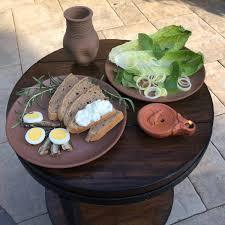
Finally, they ended their cena with secunda mensa, or dessert, consisting of baked goods and sweetened porridge On a day like our Thanksgiving, the equivalent meal for Romans would probably have been something like peacocks and dormice In fact, many of the very wealthy Romans seemed to have eaten many exotic animals as evidenced by De re culinaria, a collection of Roman recipes In contrast, poor Romans ate very little, with meals structured around their workdays. They received most of their protein from beans and legumes instead of meat or seafood and ate mostly porridge or puls.
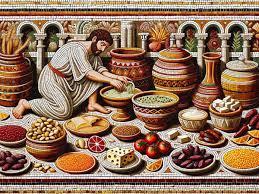
Nowadays, our ovens are powered by gas, but we still eat three meals a day and eat many of the same foods the Romans ate. And as we all sit around the table eating our dinners, thoughts of Ancient Roman cooking float through our minds.
Fan is a AP Latin student at Harriton High School and serves as the Historian for the Latin Club and the Culture Head for Harriton Certamen Team A lover of all things Rome, she also enjoys competing in Science Olympiad and swimming
KEYSTONE
AUTUMN - DEC 6 WINTER - FEB 7
SPRING - MAR 28 CONVENTION - MAY 30
KEYSTONE
SCHOOLS IN LAST ISSUE: SUBMISSION DATES:
CONRAD WEISER HIGH SCHOOL
HARRITON HIGH SCHOOL
NORTH ALLEGHENY HIGH SCHOOL
OWEN J. ROBERTS HIGH SCHOOL
PHOENIXVILLE HIGH SCHOOL
UPPER DUBLIN HIGH SCHOOL
CONTENT IDEAS:
ANNOUNCEMENTS
CHAPTER NEWS
RESOURCES
ARTWORK
GAMES
EVENT RECAPS
MODERN & COMPARISONS
MEDEA ACROSS ANCIENT AUTHORS: OVID VS. APOLLONIUS
There are a multitude of myths still existing today that contradict and conflict with each other, making it difficult to discern between what was the original belief and what has now been adopted. Many of these contradictions arise in Ovid’s “Metamorphoses,” with classics like the story of Jason and the Golden Fleece, or “The Argonautica”
Ovid’s “Medea and Jason” story which is included in his book titled “Metamorphoses” is a relatively short tale about the struggle Medea faces upon meeting Jason and how she chooses to assist him
in his tasks. It showcases how she must decide how to handle her emotions, whether to help Jason in his endeavors or to remain loyal to her father This shows a similarity to the original story crafted by Apollonius of Rhodes in which Medea is plagued by awful dreams of her family disowning her Medea eventually decides to assist Jason after he promises to marry her afterwards and Jason successfully defeats the tasks and wins the Golden Fleece.
In Apollonius’s original version, the plotline follows Jason through his quest to find and form the Argonauts, and their adventures as they sail to retrieve the Golden Fleece The story includes much more than just the portion where Medea comes in, which makes it the more fulfilling and complete version
Read more about Medea’s depictions on page 31
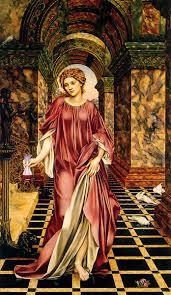
MODERN & COMPARISIONS
AUTHORS COMPARED
Aspect Ovid’s “Medea and Jason” Apollonius’s Argonautica
Narrative Focus
Primarily on Medea’s internal struggle and emotions.

Medea’s Love for Jason
Details of the Argonauts’ Journey
Briefly suggests divine intervention but focuses on Medea’s personal battle with her feelings.
Minimal summary of their travels; skips key events like King Aeetes’s terms.
Jason’s Role Secondary; exists mainly as the object of Medea’s affection.
Comprehensive account of Jason’s quest, the Argonauts’ journey, and Medea’s role.
Explicitly shows Hera, Athena, and Aphrodite persuading Eros to make Medea fall in love with Jason.
Richly detailed, covering the Argonauts’ formation, adventures, and challenges.
Fully developed character with leadership struggles and key interactions.
Moral Theme
Scope of the Story
Focuses on following one’s heart through Medea’s choice to help Jason.
Narrow, focusing mostly on Medea’s perspective and emotions.
Explores teamwork, divine intervention, and complex relationships
Expansive, incorporating multiple perspectives and events.
Continued from page 29.
Between “The Argonautica” and “Medea and Jason,” the latter story is only present in Ovid’s writings in the character of Medea Little is said about the rest of the Argonauts’ voyage, only a simple summary of their travels and little mention of the terms that King Aeetes dictated
The story only truly begins once Medea is brought into it, and from line 8 to line 73, Ovid describes the beginning of a long internal struggle in Medea as she battles her love for Jason and her loyalty to her father
The Argonautica describes precisely what is happening on both sides of the story, while Jason only exists in Ovid’s version because he is the one Medea loves The original story includes everything that Ovid’s version does, however, Ovid left out considerable pieces of information in his secondary depiction, “Medea and Jason.”
Not only does Ovid completely ignore the rest of the story of the Argonauts, he does not even begin to describe where Medea’s love for Jason came from in the first place The original story by Apollonius of Rhodes tells the tale that Hera and Athena went to Aphrodite in order to persuade Eros to cause Medea to fall in love with Jason, so that Jason would be able to complete the tasks with the help of Aeetes’s daughter
Ovid may have briefly mentioned this, as one of his lines when Medea is arguing with herself states: “It’s useless to fight, Medea some god is against you” (248) This could be a reference to where Apollonius wrote her love originally coming from, or just a coincidence
MODERN RECEPTION
But in Apollonius’s version, this is a large portion of the story of Medea and Jason, while in Ovid’s version, Medea’s emotions are explained but not their origin. Part of the reason that Ovid’s version only really focuses on Medea could be because most of the rest of Book 7 - where “Medea and Jason” is found in Ovid’s “Metamorphoses” - is also about Medea It follows her travels for a long time, never really focusing on Jason ever again.
The moral across both of these myths is to follow your heart, which is shown mainly in Ovid’s version as it focuses on Medea’s literal internal struggle with her heart However, Medea chooses in the end to follow her heart and it ends up being the right choice, that is, in this myth
Later on, Jason marries someone else causing Medea to feel incredibly betrayed, but in the circumstance presented in “Medea and Jason,” she is right to follow her heart.
This relates to the overall theme of following your heart because it is always the right thing to do something nice for someone, and to help them, no matter the consequences
In conclusion, although the two interpretations remain similar and grasp the same ideal plot, Ovid’s story chooses to focus solely on Medea while Appolonuis’s describes everything thatis happening on both sides, regardless of which character he is writing about
Ruthanne Metzger is a sophomore at Conrad Weiser High School She is a Latin II student and is an avid writer with a passion for creative expression Beyond her love for writing and Latin, she thrives in musical theater, painting, and other artistic pursuits
NATIONAL CONVENTION

72ndAnnual
National
July 21-26, 2025 | Miami University, Oxford, Ohio
Nonscholaesedvitaediscimus. Welearnnotforschoolbutforlife. DerivedfromSeneca
AgendaandConventionevents
LiliaAitSahlia,NJCLPresident|president@njcl org
ElizabethBouis,ConventionAdvisor|convention@njcl org
UniversityandLocalMatters
AmyElifrits,ConventionCo-Chair|abelifrits@yahoo com
EmelieInderhees,ConventionCo-Chair|inderhees@wellington org
ToddWegenhart,ConventionCo-Chair|programs@njcl org
SherwinLittle,ConventionRegistrar
littles@aclclassics org P 513-529-7741|F:515-529-7742
860NWWashingtonBlvd SuiteA Hamilton,OH45013 P 513-529-7741|F 513 529 7742|njcl org
Registration Opens March1,2025
Cost:TBA

INFORMATION njcl org/NJCLConvention/2025NJCL-Convention
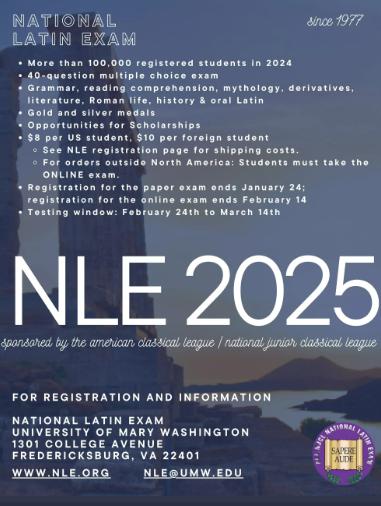
GREEKS GODS AND MODERN CELEBS
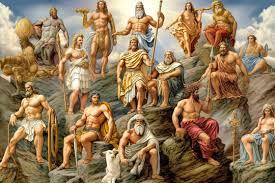
“Although the two groups lived in dramatically different times, these figures still possess similar characteristics."
One of Greek mythology’s greatest attractions are the gods and goddesses whose abilities and characteristics shape the many heart-throbbing and action filled stories. These Greek heroes and villains possess impossible powers, thus making them myths, but many modern celebrities and their film roles appear analogous to their respective Greek gods or goddesses’ qualities
Poseidon, most widely known as the god of the sea, possesses the power over water and storms His characteristics are similar to those of Jason Momoa, infamous for his role in the movie Aquaman. Both men share a strong and powerful mindset, while also sharing physical attributes, such as long hair and a muscular frame
Hades, god of the dead and king of the underworld, oversees all death, making him one of many morbid villains
In the TV show, Squid Game, Lee ByungHun portrays the Front Man, the supervisor of the entire game responsible for killing hundreds of civilians Both characters are portrayed as villains in their stories for holding accountability of numerous deaths
Artemis, the Greek goddess known for her beauty and precise hunting skills, famous for her bow and arrow, is synonymous with Jennifer Lawrence, known for her role as Katniss Everdeen in the movie series Hunger Games Katniss, also famous for her quick and accurate bow and arrow skills, survives many obstacles through her hunting expertise Both characters share their persevering and fighter mindsets while also maintaining their natural beauty

Hera, queen of the gods, is married to Zeus and is the goddess of marriage. Similarly, Beyonce is known as “Queen B” and is very influential in her respective field of music. She is married to a powerful man as well: Jay-Z Marriage is a central component in each woman’s life, as Hera is the goddess of marital unions, and Beyonce is married However, both women were cheated on by their spouses numerous times. Both women are strong and dominant figures in their own areas of expertise and are renowned for their beauty as well as success
Athena is the goddess of wisdom and heroism There are several parallels between her and actress Emma Watson, both extremely smart women Athena is the goddess of logic, her intelligence analogous to that of the former Brown University student.
Athena was also known for her beauty, similar to Watson’s elegant features. Coincidentally, Athena’s well-known symbol is an owl, and Emma Watson played Hermione Granger in the movie series, Harry Potter, in which owls are a prominent pet Both female figures are smart and successful, using their logical thinking to aid them in their journeys.
As elaborated on previously, there are many similarities between mythological figures and modern celebrities Although the two groups lived in dramatically different times, these figures still possess similar characteristics.
Rae Emma is an AP Latin student at Harriton High School and serves as an active contributor to the Latin community through awards from the National Latin Exam and participation in Latinrelated art competitions Outside of her love for Rome, she enjoys dancing Vaganova ballet, playing piano, drawing, and reading
SCIENCES & EDUCATION
LATIN MEDICAL PRACTICES
Roman notions of autonomy were rudimentary compared to modern biology today The Romans did not understand many functions of the human body, and often treated diseases in ways that could hurt the patient more than heal Romans believed that disease in humans was caused by an imbalance in the humors, Earth, Wind, Fire, and Water. These four Humors cause disease, for example say an imbalance of water and cold, meaning cold and wet environments, the symptoms would be phlegm If it was Earth out of balance then Black bile, and so on. In order to combat this, Romans would try to bring the four Humors back to balance, by consuming the opposite of water and cold, earth and fire, this would bring the humors back to equilibrium
Oftentimes certain plants embodied the four different humors, and if the Humors could be reset by consuming the plants that are the opposite Humor, fire for water, earth for wind, and vice versa If none of these homemade remedies would work, the Romans had one more trick The god Asclepius is the god of medicine and healing, if no herbs or potions worked, then Asclepius would help. Asclepius was the son of Apollo, he was a tall man with a toga, he kept a staff with him, the staff had one snake curling around a center stick Asclepius held the Staff of Asclepius, which has been the symbol of medicine since 800 BCE. The Temple of Asclepius was the hospital for the Romans, it was believed that if gifts to the god were left at his temple, then illness would be cured. The sick would stay for multiple days and nights at the temple under the watchful eye of the priests, there were obligations that had to be observed by the sick.
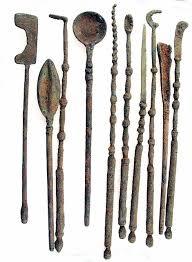
During the nights at the temple, Asclepius would appear to the sick in their dreams, oftentimes he would whisper the cure for their ailment If the illness cleared with the use of Asclepius, the rehabilitated would then return to their villa to make a sacrifice to god in the form of a goat or chicken. If nothing had worked, the afflicted would get help from a doctor In the Roman Empire, doctors were not trustworthy, and treatment included prayers, herbs, and blood letting Many patients did not survive, and there was not leading consensus on treatment, anatomy, or surgery
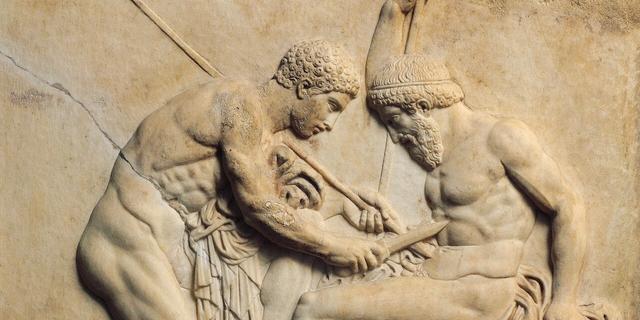
“Doctors in the Roman Empire were not allowed to perform dissections or autopsies, meaning basic anatomy was known.”
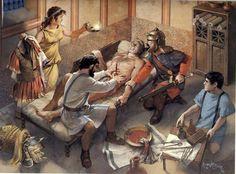
Only in 160 AD Galen (Aelius Galenus) discovered that arteries and veins carry blood, not air, as previously hypothesized Roman medical practices were primitive compared to modern understanding of medicine, and basic compared to their complex architecture and arrays of aqueducts Modern medicine has evolved rapidly and the doctors of the Roman Empire might have imagined current medicine as magic
Mason Stiles is currently taking Latin III at Owen J Roberts High School He took Latin to learn about medical roots He is also a member of the concert band and marching band, which he is a section leader in
SCIENCES & EDUCATION
Sundials like this one symbolized the ancient Greeks’ and Romans’ harmony with cosmic rhythms.
CONCEPT OF TIME IN ANTIQUITY
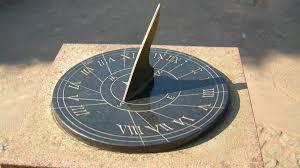
How was time conceptualized during the age of the Ancient Romans and Greeks? These civilizations are known for their technological and philosophical advancements, which shaped the concept of time in classical antiquity into a rich and multifaceted idea. It took form through mediums such as philosophy, practical necessity, and narrative tradition
Philosophers like Aristotle and Plato hoped to grasp the nature of time in their work, viewing it as an eternal, cyclical phenomenon tied to cosmic rhythms, while the Stoics emphasized its connection to fate and ethical living These abstract ideas became practical in calendars and other timekeeping systems of Ancient Romans and Greeks, where observations of astronomy and agricultural cycles determined the organization of days, months, and years These systems were heavily embedded into everyday life for example, the transition from the Greek lunar calendar to the Roman Julian calendar reflected advancements in time measurement, societal improvement, and political significance, as Julius Caesar’s reform solidified his legacy.
Aside from governance, these temporal frameworks and concepts are found deep in literature and mythology, where time served as a narrative device to explore prophecy, destiny, and human mortality Works like The Odyssey and The Aeneid manipulated time through flashbacks and foreshadowing, offering an interconnected glimpse into how these ancient societies perceived and reflected upon the connection between immortal and the mortal lives. These lenses reveal the understanding of time within ancient Romans and Greeks as an integration of philosophical thought, practical innovation, and cultural storytelling, which shapes our time keeping systems today.

HTTPS://TINYURL COM/PAJRCL
STATE OFFICERS
PRESIDENT
ROHA HERIAL
VICE PRESIDENT
SABRINA BAUER
SECRETARY
CHRISTOPHER CHANG
PARLIAMENTARIAN
SOHUM BANDYOPADHYAY
EDITOR
EMMANUELLE KRAMER
CHAIRPERSON
RYAN ZEITZER COMMUNICATIONS
QUINN MCINTIRE CONSTITUTION
KARIN SUZADIIL TECHNOLOGY
TRACI DOUGHERTY
TREASURER
KARIN SUZADIIL PROGRAMS
SARA FLOUNDERS
PUBLICATIONS
TRACI DOUGHERTY
KEYSTONE
is the official publication of the Pennsylvania Junior Classical League (PAJCL) It serves as a platform to inform, inspire, and connect members through engaging content that celebrates the study of Latin, Greek, and classical civilizations
Featuring chapter news, event recaps, contest results and student submissions including educational articles, artwork and more The Keystone highlights the achievements and voices of PAJCL members while fostering a shared love for the classics.
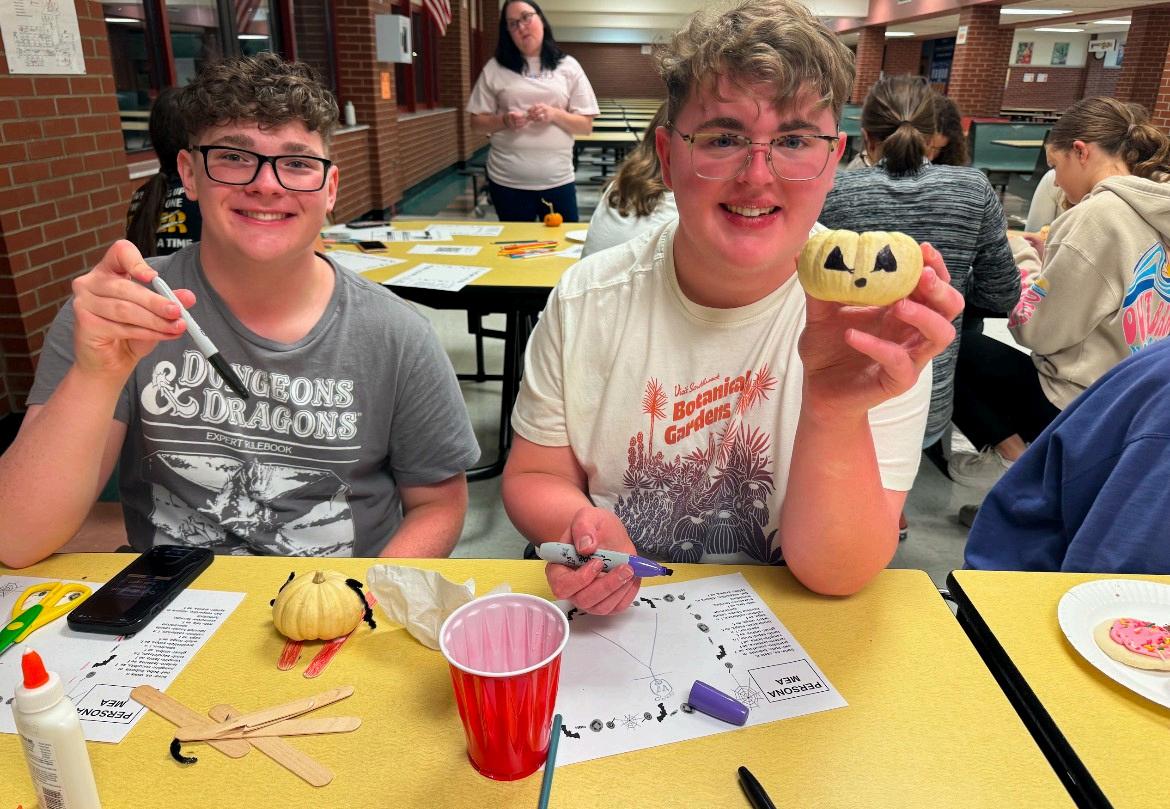
WHY JOIN?
Joining the Pennsylvania Junior Classical League (PAJCL) offers students a wealth of opportunities to engage with Latin, Greek, and classical civilizations in meaningful and exciting ways.
Through leadership roles, service projects, and participation in events like the annual PAJCL Convention, members develop valuable skills in teamwork, communication, and organization Our vibrant community of like-minded peers, allows students to build friendships and connections across the state.
For those who seek to deepen their passion for the classics, PAJCL offers a keystone to learning, leadership, and lifelong inspiration.

